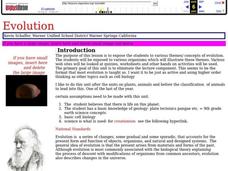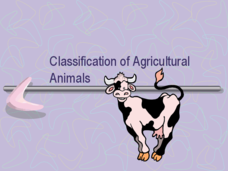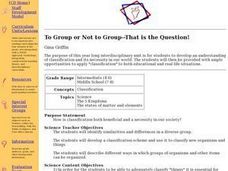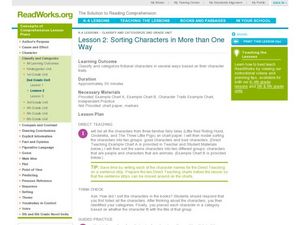Curated OER
Arthropods
A set of note-taking slides introduces your biologists to the characteristics and the four subphyla of arthropods. Nothing flashy is included, but it is a tidy and straightforward presentation that you can use when your class is...
Curated OER
Freshwater Fish Anatomy & Taxonomy
Tenth graders use a classification key to identify organisms. In this classification lesson students identify freshwater species of fish and document their observations.
Curated OER
Spring
Learners examine lichens in an outside field trip. Students explore the diversity of this organism and ask questions about them.
Curated OER
Rule It Out
Here's a way to create math fact flash cards! Learners create their own cards and sort them into matching categories. Students start with addition and work their way up to harder math such as multiplication, and are asked to notice...
Curated OER
Evolution
Explore the concept of evolution and cell biology; your class can work in groups to use the internet to view websites on evolution, take a quiz, and complete a lab activity.
Curated OER
Fun With Sorting and Classifying
Using a variety of activities, kindergartners explore sorting and classification. Learners engage in an online sorting activity, read books involving classification, and create their own class book. This is a marvelousway to explore this...
Curated OER
Classification of Agricultural Animals
Students of biology should find this powerpoint interesting as it recaps the basics of classification and Latin and common names of familiar farm animals. The slides are clear, not loaded with text, and lead the students through the...
Mr. Jones's Science Class
Periodic Table Project
Don't be fooled by the title; this is not really a lesson on elements. It is a project on classification, using the periodic table as an example. For that reason, it could be used in any branch of science. As an example, a group may...
Curated OER
Name that animal
A great way to classify organisms, is by counting the number of legs it has or how it moves. Little ones count the legs on five different creatures, then match the leg count to the proper animal name. Tip: Have them come up with other...
Curated OER
Name that plant!
What is a dichotomous key? When your kids ask, hand them a learning exercise like this one, to explain it. They use the key to identify four different trees, based on the budding twigs they've produced. Tip: Have learners extend this...
Curated OER
Seed Sensations!
First graders examine seeds. In this Science lesson, 1st graders classify and dissect seeds. Students sprout their own seeds in the classroom.
Curated OER
Hardware Sort
Students classify various hardware items using the attributes of the objects. In this classification lesson plan, students group objects based on their attributes and explain their classification key.
Curated OER
Aquatic Safari
Students use an Internet Web site to locate the scientific information about various marine species. They use the Internet to find the scientific information about marine animals.
Curated OER
Organizing Principles of Plants and Animals
Three lessons and five assessments are contained in this material. Various paper shapes are sorted as a simulation of biological classification. Learners gather a list of living things that they are familiar with and design a...
Curated OER
Are You One Of Us?
Students discover how to classify things based on their similarities and differences. Students give the characteristics of insects and create a classification list. Given examples of various types of insects, students classify them...
Curated OER
Classification: Dichotomous Key
Students investigate the classification process and nomenclatures used for classifying organisms. They study dichotomous keys to identify organisms with 90% accuracy. Students organize information regarding the relatedness of species.
Curated OER
Classification Scheme
Fourth graders discuss different classification schemes for living organisms. They group common household items to discover many ways to classify organisms. Students compare/contrast characteristics of each classification.
Curated OER
To Group of Not to Group - That is the Question!
Upper elementary and middle schoolers use their observation skills to group different kinds of candy by similar characteristics. They debate whether or not we should classify objects. Finally, they learn that biologists have developed a...
Curated OER
Sorting Characters in More Than One Way
Introduce your class to characterization. Familiar story characters are sorted into "good" and "bad" categories based on the characters' personalites and actions in the story. The class discusses and describes characters they have read...
Curated OER
Look At Those Leaves!
Students collect, measure and classify leaves. For this inquiry-based sorting and classifying lesson, students look at various types of leaves they have collected and measure them using a standard unit of measurement. Next, they relate...
Curated OER
Sorting
Students examine the concepts of organization and classification. For this library skills lesson, students practice ordering and sorting skills by playing an interactive Internet game. Students then practice their classification skills...
Curated OER
At the Seaside
Encourage sorting and classification skills by asking, "What kinds of things are found at the seaside?" Kids sort objects by calling out the items found at the beach. They can choose from things like balls, dogs, bikinis, shells, and...
Curated OER
What Makes a Plant a Plant?
For a plant unit in your biology curriculum, here is a slide show that bestows the basics of plant structure, reproduction, and classification. The information is general. The main point of the lesson is to highlight what characterizes...
Curated OER
Classification of Living Things
Biology learners will be able to explain the binomial nomenclature system and name the seven levels of classification of living things after viewing this set of slides. Brightly colored with bold fonts, the format is eye-catching, and...

























